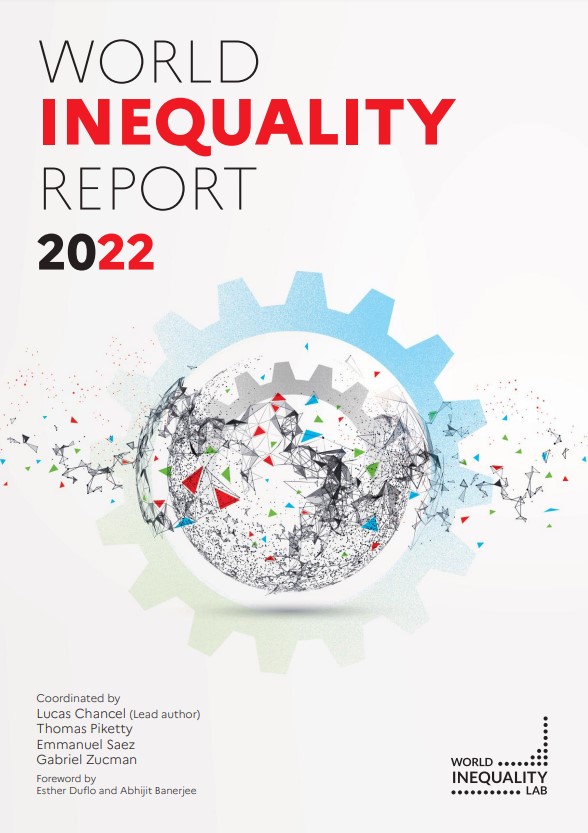□ 가장 부유한 10%가 전 세계 소득의 52%를 버는 동안 가난한 절반(50%)의 사람들은 전체 소득의 5%만을 버는데 그치고, 상위 10%가 전체 부(富)의 76%를 소유한 반면, 하위 50%는 전체 자산의 2%만을 소유함. 전 세계적으로 국가 간 소득 격차는 감소하는 추세지만, 국가 내부의 불평등은 대부분 커지고 있음
□ 국가의 평균 소득과 국민 소득의 불평등은 큰 연관관계는 없는 것으로 나타나 국가의 소득 수준이 높다고 해서 불평등 수준이 낮다는 것을 의미하지 않음. 즉 유럽과 북미의 평균 소득은 대체로 비슷하지만 불평등 수준은 현저하게 다르고, 중동 및 북아프리카 지역과 동아시아의 1인당 소득은 비슷하지만 소득 분포는 매우 다름
□ 불평등을 줄이기 위해서는 조세와 이전을 통한 재분배(Redistribution)뿐만 아니라, 세전 소득 불평등을 줄이는 선분배(Pre-distribution) 정책과 제도를 잘 활용하는 것도 중요함. 보고서는 ”소득과 부의 불평등을 해소하지 않고선 21세기가 안고 있는 과제를 해결할 수 없다”며 각국 정부가 세금과 재투자를 통한 행동에 나설 것을 촉구함
(출처: World Inequality Lab)
목차
Contents 4
Executive Summary 9
Introduction 22
Chapter 1
Global economic inequality: insights 24
What is the level of global economic inequality today? 26
Global income and wealth inequality between individuals: initial insights 26
Global income and wealth inequality between countries 28
Income inequality varies significantly across regions .30
Differences in inequality are not well explained by geographic or average income differences 31
The geographical repartition of global incomes .33
The limited impact of redistribution on global inequality 34
The complementarity between predistribution and redistribution 36
The extreme concentration of capital 37
Chapter 2
Global inequality from 1820 to now: the persistence and mutation of extreme inequality 52
Global inequality rose between 1820 and 1910, and stabilized at a high level since
then 54
Within-country and Between-country inequalities are as great in 2020 as in 1910 56
The global economic elite never fully recovered its Belle Époque opulence 58
The regional decomposition of global inequality: Back to 1820? 60
Taxes and transfers do not reduce global inequality that much 63
Understanding the roots of global economic inequality: Center and periphery
imbalances 64
Global inequality within countries is higher than inequality between countries which remains significant 68
Chapter 3
Rich countries, poor governments 72
What is wealth and what does owning capital mean? 74
Global private and public wealth: Insights 75
The return of private wealth in rich countries 76
The secular fall of public wealth was exacerbated by the Covid-19 crisis 76
The rise of private wealth in emerging countries 77
The decline of public wealth across the world 78
Net foreign wealth has largely increased in East Asia and fallen in North America 80
Financialization increased everywhere since 1980, but at different speeds 80
Economies are increasingly owned by foreigners but some have resisted this trend more than others 80
Chapter 4
Global wealth inequality: the rise of multimillionaires 86
Global wealth data remain opaque 88
How large is global wealth and where is it held? 88
The uneven increase in wealth since the 1990s 90
Extreme growth at the very top 91
The evolution of wealth inequality in rich countries 91
Wealth inequality in emerging countries 94
What is driving global wealth inequality? 95
Chapter 5
Half the sky? The Female Labor Income Share from a Global Perspective 100
Female labor income share across the world today: regional divides 102
Evolution of women’s income share across the world 104
Women earn just a third of labor income across the globe 105
The role of pay ratios vs. employment ratios 106
Breaking the glass ceiling: women at the top of the wage distribution 107
Chapter 6
Global carbon inequality 114
The need for better monitoring of global ecological inequalities 116
Global carbon inequality: initial insights 117
Emissions embedded in goods and services increase carbon inequalities between regions 120
Global carbon emissions inequality . 123
Per capita emissions have risen substantially among the global top 1% 123
Inequalities within countries now represent the bulk of global emissions inequality 126
Addressing the climate challenge in unequal societies 126
Chapter 7
The road to redistributing wealth 136
Why tax wealth? 138
Modernizing personal wealth taxation 138
Estimates for a global progressive wealth tax 139
Regional wealth tax estimates 140
Factoring-in behavioral responses to wealth taxation .141
Chapter 8
Taxing Multinationals or Taxing Wealthy Individuals? 146
The role of corporate tax in the progressivity of the tax system 148
The decline in corporate taxation since the 1980s 150
The promises and pitfalls of minimum taxation 150
Chapter 9
Global vs Unilateral Perspectives on Tax Justice . 154
Usefulness of unilateral approaches: the case of FATCA . 156
Estimates of unilateral vs. multilateral tax deficit collection 157
Anti-tax evasion schemes contain many loopholes and cannot be assessed 159
Properly assessing the road towards tax transparency: publishing basic
information 160
Towards a global asset register 160
Chapter 10
Emancipation, redistribution and sustainability 164
The rise of the Welfare State in rich countries (1910-1980) 166
The limited rise of tax revenue and public spending in emerging countries
since 1980 167
The stagnation of global tax revenue and social expenditure (1980-2020) 168
Lessons from failed trickle-down economics 168
The 1980-2020s have been marked by a rise of tax evasion, further undermining tax progressivity 170
Using 21st-century progressive tax revenue to invest in education, healthcare and the environment171
Global redistribution: moving beyond development aid 172
Ending center-periphery imbalances 173
Glossary 178
Country-sheets 179



